A few weeks ago, i was intrigued by the description of a work presented at the grow_ability exhibition in RIXC Gallery in Riga, Latvia. The art show explored sustainability in relation to our planet’s ecology from a “food as energy” perspective.
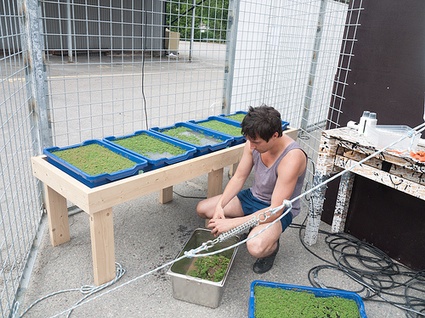 Image courtesy of Erik Sjödin
Image courtesy of Erik Sjödin
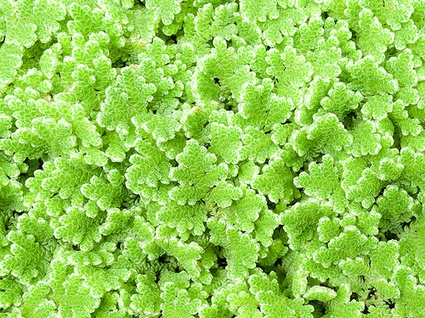 Image courtesy of Erik Sjödin
Image courtesy of Erik Sjödin
One of the three works on show was Erik Sjödin‘s Super Meal which investigates whether an aquatic plant called Azolla could become a key ingredient of the fast food joints of the future. Azolla is cheap and easy to cultivate, it grows super fast and is rich in nutrients. Yet the possibility that this fern could become a staple of our meals has received very little interest so far. Recent research, however, are considering the potential of azolla for space agriculture, in particular in the event of a colonization of planet Mars.
Interestingly, azolla is believed to have had a significant role in reversing the greenhouse effect in the middle Eocene period, some 49 million years ago. The fern colonized the region around what was then a hot, tropical Arctic Ocean. Because of its outstanding nitrogen and carbon fixing capabilities, azolla caused the atmospheric carbon dioxide content to drop from 3500 ppm (parts per million) to just 650 ppm, eventually turning the Arctic Ocean into its present icehouse state. This biogeological event is known as the Azolla event.
Sjödin experimented with farmers, chefs and scientists to experiment with azolla in the kitchen but also to reflect on how our food is being produced today and how it can be produced in the future.
So far the artist has presented his Azolla cultivations and experimentations at Färgfabrikensin Stockholm, at Kalmar konstmuseum, RIXC Gallery in Riga, at Kultivator in rural village Dyestad, on the island Öland (Sweden) and of course on his own balcony in Stockholm.
If you find yourself in Nordic countries in the coming months, check out the project at Rogaland Kunstsenter in Stavanger, Norway and at Salo Art Museum, Finland, in Autumn.
If you can’t make it to Norway or Finland, here’s a short interview with Erik about Super Meal:
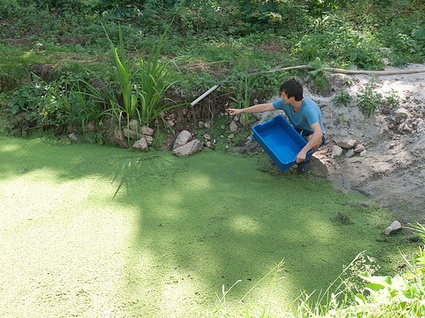 Image courtesy of Erik Sjödin
Image courtesy of Erik Sjödin
I’m interested in the way you try to engage the public into your research about azolla. You have already exhibited this project in several art spaces. How does the azolla project take shape? Do you change strategy each time you exhibit it? cooking at Färgfabriken for example and doing something else in Riga?
What I end up doing is shaped a lot by the circumstances. At Färgfabriken in Stockholm I exhibited in the summer and they had a courtyard so it was possible to grow azolla outside. RIXC‘s exhibition in Riga was too early in the spring for it to be possible to grow azolla outside and the room I exhibited in didn’t have any windows so I had to grow the azolla under artificial lights. I also try to find people to collaborate with around the exhibitions. At Färgfabriken I got the chef at Färgfabriken’s café to experiment with azolla cooking with me. When I exhibit in Finland in September I will collaborate with a local gardener who will be growing azolla which we will cook on the opening weekend. I exhibit Super Meal as a work in progress because I think that an ongoing process can be more interesting and engaging than the conclusion. The project has always been more about the process than the result, but it’s not that I don’t care about the result. I’m hoping to arrive at something, but the result is the outcome of the process and in that sense the process is everything. I guess that finding new ways of working, or living if you want, is very much what the project is about for me.
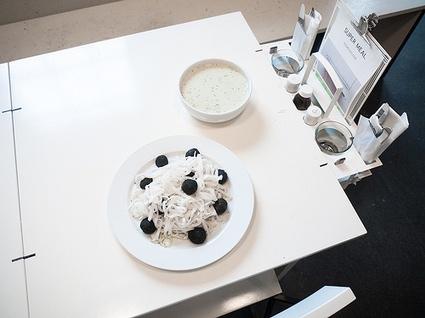 Image courtesy of Erik Sjödin
Image courtesy of Erik Sjödin
You are going to exhibit Super Meal again in end of May / June at Rogaland Kunstsenter in Stavanger. What will the work look like exactly in Stavanger? Will you be cooking, growing azolla?
I’ll exhibit photo documentation of the project and I’ll be making an installation inside the gallery where I’ll be growing azolla. There will also be a reading corner where a draft of the Azolla Cookbook and Cultivation Manual I’m working on will be available along with some literature that relates to the project. Two texts that I’ll include are Tomorrow is Our Permanent Address by John Todd from the New Alchemy Institute (NAI) and the sociologist and philosopher Bruno Latour‘s text An attempt at a “Compositionist Manifesto”. The NAI was a research center that did
pioneering research into agriculture, aquaculture and architecture in the 70’s and
80’s. In 1976 they experimented with azolla as a mulch for lettuce. The results of
these experiments were published in the 1977 issue of their journal, the same issue
in which Tomorrow is Our Permanent Address was published. Already in the 70’s the NAI were doing and thinking about much of what is being talked about as novelties today. In Tomorrow is Our Permanent Address, John Todd talks about exploring a “new synthesis”; how “biological consciousness would fundamentally alter our sense of what human communities could be” and how “in the adaptive model of nature lie design ideas that will enable humans to create societies and cultures as beautiful and as significant as any that have thus far existed”.
Bruno Latour takes interest in the so called nature / culture dichotomy and argues
that it has become untenable. In An attempt at a “Compositionist Manifesto” (published in 2010) he talks about how “everything happens as if the human race were on the move again, expelled from one utopia, that of economics, and in search for another, that of ecology” and that perhaps it’s time to “innovate as ever before, but with precaution” if we are to build a livable and breathable “home”.
This is what I know will happen in Stavanger. I’m also trying to involve the Norwegian Gastronomic Institute in Stavanger in the project. I’m hoping that we can make a larger outdoor azolla cultivation somewhere and experiment with azolla cooking together but nothing is set yet. Throughout the summer I will also be working with Oloph Fritzén, farmer at Hästa gård, a 180 hectare urban farm in Stockholm. We’ll try to make some kind of azolla installation on the farm and grow azolla to use as mulch and as fodder for the farms animals. In September I’ll exhibit Super Meal at the Halikonlahti Green Art Trilogy in Finland. For that exhibition I’m collaborating with Tiia Pau, a gardener who will be growing azolla in Salo during the Summer. During the opening weekend of the exhibition I’ll be facilitating an azolla kitchen where people can drop in and experiment with azolla cooking.
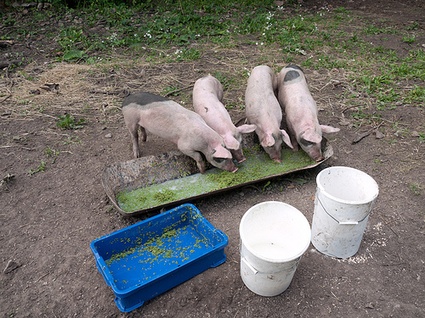 Image courtesy of Erik Sjödin
Image courtesy of Erik Sjödin
Azolla has been used for biological fertilizer and as animal fodder. At some point in the booklet, you call it ‘not super tasty’ and you even add further on “To sum up you eat azolla on your own risk. It might be healthy and it might not.” That was quite a warning! So what is your aim with the Super Meal project? To convince people that it’s a valuable food resource? Or rather to enter in a broader discussion about the future of food and food production for example?
I’m trying to find out if there is any real potential in azolla as a food for humans but I haven’t reached any conclusions yet and I want that to be clear. As far as I know no studies have been carried out on the effects on humans of azolla consumption so no one really knows weather it’s healthy or not. But I will rewrite that sentence before the booklet is published. I don’t want to overemphasize the risks either. Apart from potentially being a new foodstuff azolla has many applications, as biological fertilizer, animal fodder and for biofuels for example. I want to disseminate this information so that people can find appropriate uses for azolla but I don’t want to “sell” azolla or give any illusions that it’s a panacea.
I’m interested in how we produce our food today and could be producing it in the future and I try to get some insight into this by looking at how azolla can be used in agriculture. When I started to work with Super Meal I knew very little about agriculture. Now I know enough to be convinced that the industrial agriculture we have to day is a dead end and that we ought to move towards an agriculture based on a diversity of species working together in stead of ever larger monocultures dependent on fossil fuel driven machines, synthetic fertilizers and pesticides. The way I see it this isn’t a matter of going back to a pre-modern agriculture but of putting together both old and new knowledge of how the world functions and creating something that we’ve never had before. Azolla has been used as an organic fertilizer in rice paddies for thousands of years in parts of China, but it isn’t until recently that this practice has started to spread to other parts of the world.
Experiments with azolla in rice cultivation has for example just started in Italy where rice producers have problems with pollution and depleting soils. Using azolla as an organic fertilizer in rice paddies is great, but when it becomes really interesting is when even more species are introduced in the paddy. A farmer in Japan, where azolla commonly is regarded as a rice paddy weed, has recently shown that if rice is co-cultured with azolla, fish and ducks in the same paddy you can get greater rice yields than with conventional rice farming while at the same time getting fish, duck meat and eggs. I think that systems like these are really promising and that what we need to do is to develop an agriculture with both a a great diversity of systems and great diversity within the systems themselves.
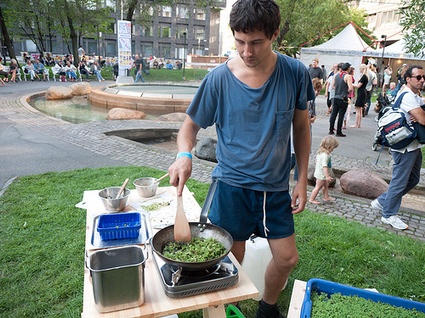 Image courtesy of Erik Sjödin
Image courtesy of Erik Sjödin
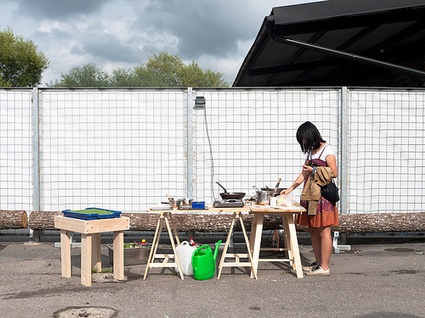 Image courtesy of Erik Sjödin
Image courtesy of Erik Sjödin
How does the public react to your project?
Most people I’ve met are really curious and enthusiastic about the project. It’s fun to
look at, touch and eat a plant you haven’t heard of before. Especially one as odd as azolla, a floating fern that lives in symbiosis with an algae and grows like crazy. I also think that a lot of people are inspired by the project because it’s an amateur pursuit and because it’s an attempt to look at how we can improve things. The only negative reaction I’ve received was when I presented the project at a permaculture course. I mentioned that scientific studies have shown that cow’s milk productions can be increased and that chickens gain weight if they are given azolla as a supplemental fodder. This prompted some strong negative reactions from a woman who associated this with pushing animals too far and treating them as biological production units rather than conscious beings. There was also a discussion around the appropriateness of introducing azolla in agriculture in Sweden where it isn’t an indigenous species. If azolla would be introduced in the wrong environment it could become a problem. There are already examples of this having happened in Iran for example. However, I’ve found a Swedish garden enthusiast who has been growing azolla in a pond in Stockholm for the past ten years without it ever surviving the winter so I don’t think we need to worry about it spreading uncontrollably at these latitudes. These are relevant concerns though.
I’m interested in our notions of what is “natural”, how these notions are connected to language and aesthetics and how they are tied to how we relate to the past, the present and the future. I think we need to look beyond appearances at how things actually function and consider both new and old practices.
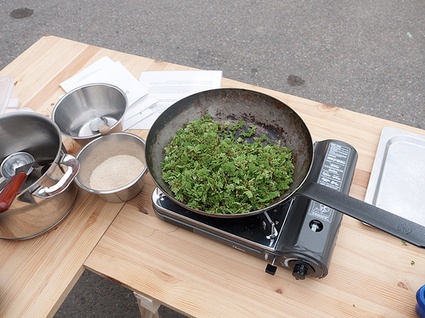 Image courtesy of Erik Sjödin
Image courtesy of Erik Sjödin
The nickname of azolla is super plant. How come i read all those health magazines full of ‘super food’ articles and i’ve never heard about azolla? Could it become the new tofu one day?
I don’t know why the health food industry hasn’t picked up on azolla yet. My guess is that they just haven’t heard of it, though it seems strange. I don’t think it would be difficult to market azolla as a health supplement, like spirulina, and make a profit from it. I’ve been contacted by people who have been interested in growing azolla as health food and I have been asked if I have intentions of doing this myself, which I don’t.
Tofu and in particular Quorn are interesting foodstuffs. Many people don’t know what they are made of or how they are made but they still eat them. Quorn is also interesting because it’s a newly invented foodstuff. In the 60’s it was predicted that by the 80’s there would be a global famine and shortage of protein-rich foods. Quorn is the result of research that was done in response to this. The fungus that Quorn is made from was discovered in 1967. After it had been evaluated for ten years the company that makes Quorn got permission to sell it for human consumption in the 80’s. The global famine never happened but Quorn ended up being a great vegetarian substitute to meat. I don’t find it unlikely that azolla could be turned into a foodstuff like Quorn or tofu with the right processing, but a lot more research has to be done.
In the introduction of your booklet ‘Super Meal’ you thank Masamichi Yamashita at Japan Aerospace Exploration Agency (JAXA) in because his work, you write, has inspired this project. What did JAXA make with azolla? Did they manage to successfully include it in a diet? What was in it in JAXA research exactly that triggered your idea to work on a project about azolla?
I was impressed that by designing systems similar to the rice-fish-azolla-duck system I mentioned earlier, and including azolla in a human diet, it would theoretically be possible to grow all the food a human needs in an area of 200 square meters. That’s less than a hundredth of the area the average Americans food production occupies today. This made me curious of what azolla tasted like and since I couldn’t find any azolla recipes or satisfying accounts of what azolla tasted like anywhere I decided to try to grow it and cook it myself. For many people space and the future are synonymous so I thought it would be interesting to look into how we produce our food today and could be producing it in the future using space agriculture research as a starting point. I think a lot of valuable knowledge can come out from research on space colonization but at the same time I find our fascination with it kind of peculiar. I recently watched Werner Herzogs’ The Wild Blue Yonder where a researcher talks enthusiastically about how in the future we’ll be living and working on asteroids and going to Earth on vacation. Why would we want to do that? Living on an asteroid and eating azolla doesn’t sound that appealing to me. I’d rather see that we try to find ways of co-existing with the diversity of species that we still have left here on Earth so we can continue to have varied food.
Thanks Erik!
More images of the Super Meal project.
